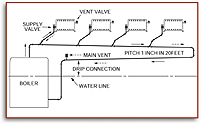You need to find the answers to these questions before you install the new boiler so that the boiler failure won't happen again. (If it fails again, watch how quickly the homeowner's steam system becomes your steam system!)
SIZING THE REPLACEMENT BOILER
Proper sizing of the new boiler plays a major role in the success of your replacement job. It is very important to ensure that the new steam boiler has the same capacity in producing steam as the system you are connecting it to has in condensing the steam. This is the one fact that trips up many contractors.Steam systems are nothing like hot water systems when it comes to providing heat. In a hydronic system, the boilers, pipes, and radiation are filled with water. The boiler heats the water, which is then circulated out to the radiation. There, it gives off some heat to the room and drops a few degrees in temperature. The water then comes back to the boiler where it is heated and recirculated back out to the system.

Regardless of the size of the old boiler, you should always walk around the house with a clipboard and add up the EDR ratings of every radiator. When you are done, you will know the exact size boiler required for this home. If you select the replacement boiler by reading only the rating plate of the old boiler, the success of the job and your company's reputation are in the hands of the installer who came before you. In addition, many homeowners believe that when they purchase a new steam boiler, they are also getting a new steam system. Their old system could have been experiencing problems for years, all because of the incorrect size of the old boiler. If you come in and select the replacement boiler based on the old one, you may then have to live with a very unhappy customer. It happens often.
When a replacement steam boiler is oversized, it can create many problems. It will force too much steam into the piping system, creating velocity problems, spitting steam vents, and water hammer noises, and causing the boiler to short cycle. Remember that the homeowner doesn't know about the need for proper boiler sizing. He hears the boiler constantly cycling on and off. All he knows is that his radiator vents are suddenly spitting water all over the walls and floor, and he believes that his house might explode from the water hammer noises. You - and your customer - can avoid these problems by taking the time to properly select the replacement steam boiler.
Reprinted with permission from the McDonnell & Miller/Hoffman Specialty newsletter CounterPointâ„¢, volume 9, issue 1. For more information on steam systems, visit the McDonnell & Miller Website at www.mcdonnellmiller.com and the Hoffman Specialty Website at www.hoffmanspecialty.com.
Publication date: 10/09/2006





